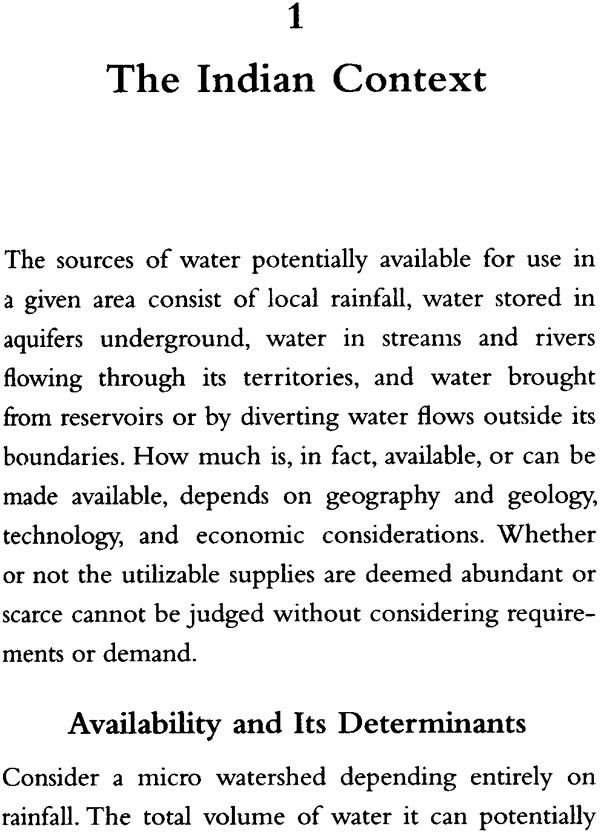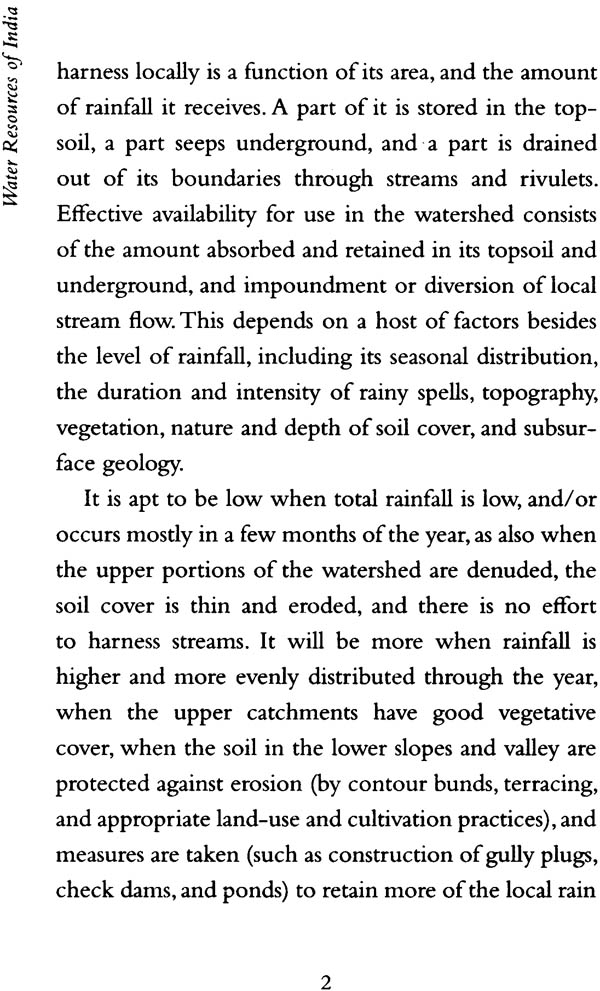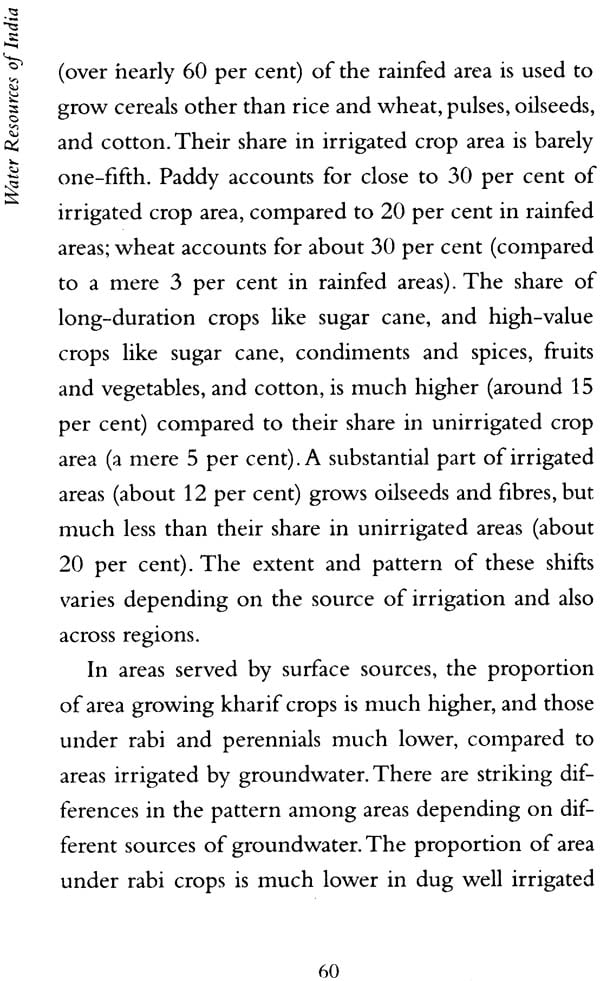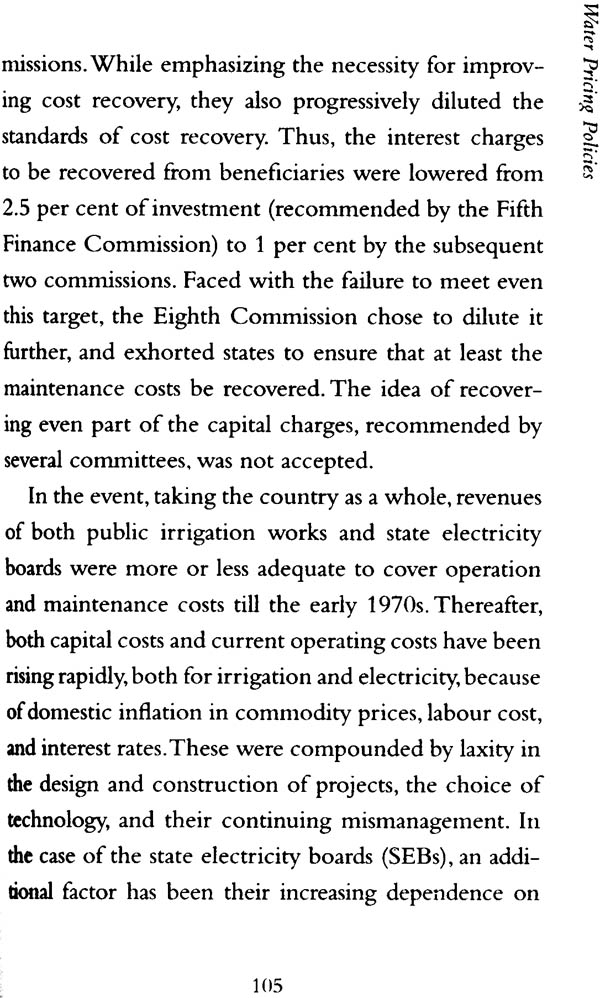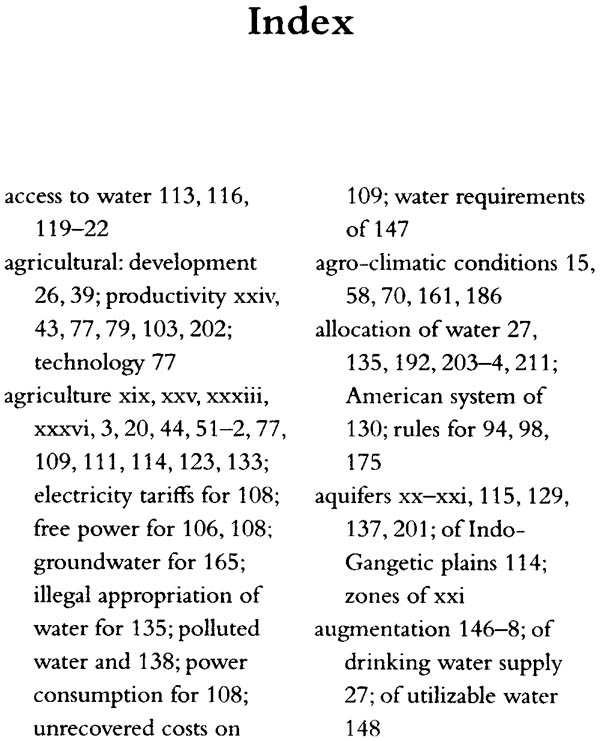
Water Resources of India
Book Specification
| Item Code: | NAJ509 |
| Author: | A. Vaidyanathan |
| Publisher: | Oxford University Press, New Delhi |
| Language: | English |
| Edition: | 2013 |
| ISBN: | 9780198090427 |
| Pages: | 271 |
| Cover: | Paperback |
| Other Details | 7.5 inch X 5.0 inch |
| Weight | 240 gm |
Book Description
The global watr crisis is no longer a doomsday prophecy, as manifest in the widespread incidence of water scarcity and conflict, depletion of groundwater, and pollution of water sources. drawing on global and Indian literature as well as field studies, this short introduction provides a holistic analysis of water-related issues and identifies the shortcomings in the present water governance system. The author makes a case for radical changes in strategy and policy, with a shift in focus from merely supply augmentation to encouraging civil society participation, carrying out water governance reforms, and providing incentives for efficient water use.
A.Vaidyanathan is currently Honorary Fellow at Centre for Development Studies, Thiruvanathapuram. His earlier books with OUP include Agricultural Growth in India: Role of Technology, Incentives, and Institutions (2010), Indian's Water Resources: Contemporary issue on Irrigation (OIP 2008),Institutions and Markets in India's Development: Essays for K.N. Raj (co-edited with K.L.Krishna, 2007), and Water Resources Management: Institutions and Irrigation Development in India (OIP 2001).
The world is facing a serious, and worsening, global water crisis. So is India. Its sings manifest in the increasingly widespread incidence of water scarcity and conflict, the depletion of groundwater, the deterioration of the environments, and the pollution of water sources. People and communities experiencing the impact of these on their lives and livelihood are naturally more concerned about coping with their immediate problems rather than with their larger dimensions and societal implications. Policymakers, planners, and the political class tend to view these problems I short-term perspectives, and look for piecemeal solutions for particular uses and in particular regions, unmindful of the fact that their different manifestations and underlying causes are interrelated.
Effective solutions need to address the complexity of the problems relating to water, and be dealt with in integrated and holistic ways. This monograph presents such a perspective.
Overall supply of freshwater from rainfall, both directly and indirectly, contributes to renewable supplies of surface water and groundwater. The necessity for tapping these renewable supplies arises because climatic conditions (reflected in the quantum and reliability of rainfall, temperatures, and their seasonal distribution) make effective availability from local precipitation limit the kinds of crops that can be grown and their yields. The supplies are also inadequate to meet domestic and non- agricultural requirements for a growing population. The monograph, therefore, begins with an explanation of the determinants of freshwater supply.
The water needs for agriculture depends on the climate, and the demand for food and fibre; the requirement for non-agricultural uses is a function of the degree of industrialization and urbanization. Both, especially the requirements for non-agricultural uses, increase with growth of population and incomes. The potential for tapping renewable supplies depends on the magnitude of surface water and groundwater resources.
The extent to which they can be tapped is constrained by technology, the capacity to mobilize investment (and manage it on a large scale), and considerations of economic viability. The existence of vast variations across and within countries in all these respects, and their underlying factors, are highlighted.
Indian’s need to tap renewable supplies for agriculture is greater as compared to both countries in temperate climates and in East Asia because of its hot climate and the high seasonal concentration of rainfall, which is preceded and followed by long dry seasons. The demand for domestic and non-agricultural uses, though relatively small now, is growing rapidly. However, water needs, regional differences in climate and terrain, sub-surface geology, and the potential for renewable supplies of surface water and groundwater vary widely across regions.
Historically, available technology permitted only the limited use of renewable supplies. Being largely determined by the local climate as well as by the proximity to streams and natural storages, the productivity of land remained very low, and variable. It is only in the second half of the twentieth century that a combination of the increasing requirements of a growing population, technological advances, and government strategies to exploit land for increasing food production let to the rapid utilization of water supply from large-scale storages, canal systems, and groundwater.
The key elements of this strategy—its outcome in terms of the increase in the volume of additional water from the surface and the ground, and the growth of irrigated area and overall agricultural production—are recounted in some detail. The spread of irrigation, combined with improvements in agricultural technology, played a key role in transforming this sector from one of near stagnation to one of sustained—and historically unprecedented—growth in the early decades after Independence. It also accounts for the bulk increase in output. However, currently, the increase in irrigated crop yields—both per hectare and per unit of water consumed—is, by all accounts, much below the attainable potential due to many factors: the underutilization of the capacity of surface system, the wasteful use of water actually supplied, and the sub-optimal use of new, proven, and available agrochemical technology.
The reasons for these can be traced to deficiencies in the design and implementation of water resource development programmes, and in the institutions of water governance. These arise from the conflation o authority for the development, regulation, enforcement, and conflict resolution functions in executive agencies of stage governments; the fuzziness of rules governing allocations and use, and their lax enforcement; the absence of any credible mechanisms for redressing grievances; the highly subsidized supply of water and energy from public system (quite unmindful of the impact of this on the fisc, as well as the efficiency of water use); and a strong propensity of government to exercise their authority in arbitrary ways to suit political expediency.
All these issues have had many seriously adverse consequences. Besides resulting in virtual anarchy in the management of water resources, they have induced the widespread unauthorized extraction and use of water, encouraged its wasteful and inefficient use, and given added impetus for demand to grow much faster than available supply. While water-related conflicts—and the resultant social and political tension—have become more widespread and intense, the overexploitation of groundwater as well as the adverse impact on the ecology and environment have also been aggravated. Attempts to address them—through programmes for the speedier utilization of potential, the modernization of existing systems, greater user participation, and the restructuring of public institutions—have been hesitant and limited to a few states. Moreover, they have not had much of an impact. The basic strategy of consecutive governments has been to continue to focus on augmenting the supply of surface water and groundwater.
In order to arrest and reverse these trends, a radical change in strategy and policy is needed. These will have to be combined with concerted and mutually reinforcing measures to improve physical facilities, restructure institutions, create strong inducements for the prudent and efficient use of water, and to check the adverse impact on sustainability. Some of the changes needed are as follows:
Reduce the importance given to the augmentation of supplies, and give far greater attention and resources to repairing and modernizing existing surface systems and distribution networks by equipping them with regulatory devices for better, more flexible regulation of water.
Reduce the fragmentation of authority and responsibility between different departments, both in the states and at the Centre.
Limit the role of the government to deciding broad objectives and priorities, and the legal framework, leaving the managerial, regulatory, and conflict resolution functions to entities autonomous of the government.
Vest all managerial functions in autonomous, user-managed organizations from the basin level down to individual systems and watersheds, without government interference, but subject to their functioning and policies being reviewed by an independent regulatory authority
Create strong incentives for the prudent and efficient use of water by reducing the burden of implicit subsidies through a progressive and graduated increase in water and energy prices to levels that cover costs
Implementing such far-reaching reforms is, of course, difficult. The political class and the bureaucracy have strong vested interests in continuing the present regime. Users will resist any increase in water rates. Overcoming both the predictably strong opposition from all these groups as well as the practical difficulties in the way of changing a functioning regime, are daunting tasks.
However, failure to confront them is no option either as it would lead to worsening of the water crisis. A calculated strategy is needed or educating al stake-holders, and strengthening ongoing efforts at reforms by extending their scope, tackling practical difficulties, and demonstrating the benefits of the reform package by implementing all its elements in select locations.
Water is critical for the sustenance of life, health, and well-being of humans, plants, and animals. The avail- ability of water, in terms of volume and reliability, determines (a) the availability of adequate and safe water for human consumption; (b) the nature, extent, and productivity of agriculture that produces essential foods and fibre; (c) the growth of forests, grasslands, and tree crops; (d) the generation of energy, and the provision of non-agricultural products and services; and (e) the maintenance of the ecological balance and biodiversity.
The ultimate source of all freshwater on earth is rain and snowfall. Frozen ice fields in the Arctic and Antarctic regions, permanent ice in mountain glaciers elsewhere, and water stored in deep underground aquifers contain freshwater accumulated over centuries. But, relative to annual rainfall, the volume stored in them is very small. Rainfall occurs from clouds formed by moisture that evaporates from oceans, from natural or man-made water bodies that store water, from for- ests, crops, and all other vegetation. Of these, by far the most important part of the total evaporation is from oceans that contain 97 per cent of the earth's total stock of water. This occurs mostly during the summer season. Evapotranspiration (ET), that is, the amount of evaporation and plant transpiration from the Earth's surface to the atmosphere is also a function of tem- peratures: it is more in the tropics (where temperatures are higher compared to temperate climates), and in the summer as compared to rainy/winter seasons. Perennial vegetation-consisting of forests and long-duration crops-has higher rates ofET than seasonal crops. Very little evaporation occurs on uncultivated land.
The average annual precipitation over the world's land surface is approximately 836 mm, comprising 97 mm of snow and 739 mm of rainfall. About 60 per cent of this (498 mm) returns to the atmosphere due to (a) evaporation of incident rainfall from uncul- tivated land, exposed patches on cultivated land, and water bodies; and (b) vapour transpiration from natural and cultivated vegetation. The remaining 40 per cent emerges as water flowing in surface river systems, and as a source of replenishing groundwater aquifers.
A little more than a fourth of the rainwater flows away as subsurface runoff, and one-eighth of it emerges as surface runoff. A part of the rainwater that reaches the ground seeps through the topsoil to build up or replenish underground storages of water called aqui- fers. Its magnitude depends on (a) the quantum and intensity of rainfall, its distribution, and the duration of the rainy season; and (b) geological characteristics-in terms of permeability, porosity, and volume-of the aquiferous zone. This storage can be, and is, used to augment water supplies from rainfall. With advances in technology that have made it possible to tap and lift water from greater depths, the intensity of exploitation has greatly increased.
Mter naturally recharging moisture in the topsoil and increasing or replenishing the underground aqui- fers, the surplus of rainfall emerges as surface flows. Some of it fills water bodies, large and small, in natural depressions; the rest feeds streams that flow into the tributaries of major river systems. So long as they are not diverted or impounded in storages along the way, practically all the rest eventually empties into the ocean.
Before the advent of settled agriculture, the nature of vegetation and the volume of biomass produced was determined by the quantum of water available for these purposes from local rainfall and stream flows. Desert regions, with little or no rainfall, had little or no vegetation and could sustain very few, if any, living beings. In regions of higher rainfall, there is an increase in the density and productivity of natural biomass generation, with high rainfall regions being marked by dense forests and a high diversity of flora and fauna. Water needs of humans were met from local streams, natural ponds, and lakes. Nomadic pastoral communi- ties raised large herds of domesticated animals by graz- ing natural pastures, often requiring seasonal migration over considerable distances. The growth of the human population beyond levels that could be sustained by hunting, gathering, and shifting cultivation led to the emergence of settled communities and the cultiva- tion of land to produce food. Settlements tended to concentrate in areas-usually in river valleys with fertile soils and abundant and assured natural water supply-that were better placed in terms of potential crop yields.
As the population in settled areas grew, new. lands in contiguous or nearby areas were brought under cultivation. However, this required clearance of forests, entailing conflict with animals, and making the land fit for cultivation almost entirely by mobilizing human labour. Areas where the scope for such expansion was large could su rain a larger population which, in turn, could muster more labour power needed for reclama- tion. The process of population growth and reclama- tion tended to go hand in hand. Further expansion was possible only by improvements in agricultural techniques and the augmentation of water supplies available from local rainfall accumulating in naturally formed lakes and ponds, by man-made devices like tanks, the diversion of water from local streams, and the use of groundwater from shallow wells.
| List of Tables | VII | |
| Preface | IX | |
| Aknowledgements | XVII | |
| Introduction | XIX | |
| 1 | The Indian Context | 1 |
| 2 | Evolution of Water Control | 19 |
| 3 | Impact of Water Resource Development on Agriculture | 51 |
| 4 | Problems of Implementation and Management | 79 |
| 5 | Water Pricing Policies | 102 |
| 6 | Inequalities in Access to Water | 133 |
| 7 | Conflicts over Water | 128 |
| 8 | Solutions for Effective Water Management | 146 |
| 9 | Prospects for Reform | 189 |
| Further Reading | 217 | |
| Index | 225 |
